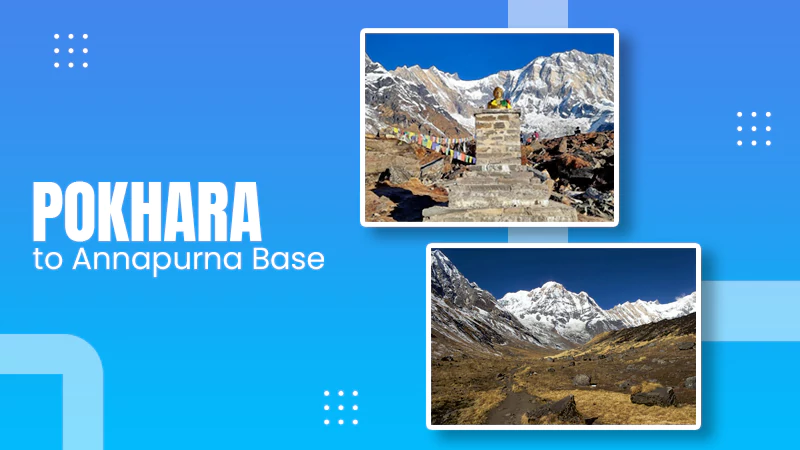
- 1. Pokhara: The Ideal Starting Point
- 2. Trekking Route and Trail Options
- 3. Cultural and Environmental Encounters
- 4. Managing Altitude and Acclimatization
- 5. Teahouse Accommodation and Food Experience
- 6. Ideal Seasons for Trekking
- 7. Permit Requirements and Cost Considerations
- 8. Safety, Insurance, and Emergency Support
- Conclusion
Annapurna Base Camp (ABC) is the most incredible trekking destination in Nepal. The journey starts in Pokhara. If you want to be immersed in nature, this is the place to plan your vacation at least once. To organize your trip, you can contact authorized agents or even visit Pokhara privately.
However, there are certain permits you must obtain before beginning your trek. If you want to learn more, read the article below. In this guide, we have tried to include everything you might want to know. Let’s begin without any further ado.
1. Pokhara: The Ideal Starting Point
Pokhara is the start of the journey to reach Annapurna Base Camp. It is a peaceful city that is situated near a very old lake. This point of beginning is nearly 200 kilometers away in the west of Kathmandu. If we talk about the altitude, it is 800 meters.
At such an elevation, the atmosphere becomes automatically peaceful and serene. Enjoying mountain top reflections on the water surface of Phewa Lake takes the whole experience to the next level.
2. Trekking Route and Trail Options
The Annapurna Base Camp (ABC) trek from Pokhara typically takes 7 to 8 days, as it largely depends on an individual’s capability. One who is part of this multi-day trek has to go through lush forests, rustic villages, and purifying rivers. All these natural elements make this hike a completely elevating experience for newbies.
On the way, you hike through villages like Ghandruk, Chhomrong, Bamboo, Deurali, etc. This route spans approximately 115 kilometers both ways. The trail follows through a diverse forest region.
3. Cultural and Environmental Encounters
During this long hike, all the hikers get to be part of a culturally rich atmosphere. Interact with local communities and give your journey a human touch. Connect and talk with Gurung and Magar, the primary ethnic groups in the area.
These regional people have preserved their language, clothing, customs, and culture for years. Spending some time with them on the way will provide you with a whole new perspective on life! You can learn a lot from their life struggles and force yourself to be more grateful.
4. Managing Altitude and Acclimatization
The trek from Pokhara to Annapurna Base Camp (ABC) is the perfect example of a comfortable elevation increase. Here, the altitude rises gradually step by step. The trek begins at under 1,000 meters and reaches approximately 4,000 meters at the base camp.
People on the way, as a result, don’t feel sick, and their bodies adjust to changing atmospheric conditions comfortably. Otherwise, rising altitude leads to breathing problems due to a decrease in oxygen levels. Subsequently, it leads to symptoms of headache, nausea, and dizziness.
If you feel sick in any way on the way, make sure that you connect with a medical practitioner as soon as possible.
5. Teahouse Accommodation and Food Experience
You will enjoy the most common yet comfortable type of accommodation here. It often comes in twin-bedded arrangements. Amenities include mattresses, pillows, blankets, etc. However, you will have to share the bathrooms.
There is typically only one joint toilet and bathroom unit available per several rooms. Living around the teahouse accommodation will help you get a great experience. As far as food is concerned, there is a variety of food available, such as Nepali, Tibetan, Western, etc.
6. Ideal Seasons for Trekking
If you are asking for ideal seasons for this trek, there are two times for you to consider. First, you can consider from March to May, and second, from September to November. Periods fall in the spring and autumn seasons, respectively. You will be able to spot and enjoy panoramic and memorable views easily.
7. Permit Requirements and Cost Considerations
You must have two permits before enjoying this long trek. The first part is the Annapurna Conservation Area Permit (ACAP) and the Trekkers’ Information Management System (TIMS) Card. Anyone interested in the hike can get these permits in Kathmandu or Pokhara through the Nepal Tourism Board or Authorized agents. The cost of both these essentials spans 5,000 rupees.
8. Safety, Insurance, and Emergency Support
For ultimate security, ensure that you have bought travel insurance that covers high-altitude trekking, medical expenses, and emergency helicopter evacuation. It is always great to hire a guide or porter to make the journey even more convenient.
Such local service providers often know the regional areas better than anyone else. By hiring, you take advantage of their local knowledge. And, finally, always have an emergency fund by your side for unexpected events.
Conclusion
If you’ve always wanted to go on a multi-day hike, this is the best option to consider. Plan a typical 7-day trip into the heart of Nepal from Pokhara to Annapurna Base Camp. During the trek, you’ll experience soothing diversity in nature, from valleys, gorges, forests, and steep climbs to rocky terrains.
So, for a truly refreshing experience away from the chaos of daily city life, this holiday option is the best. It is also very affordable. You won’t have to spend much, thanks to budget-friendly accommodations and other essential facilities available in the region.











